Bharhut
| Bharhut | |
|---|---|
 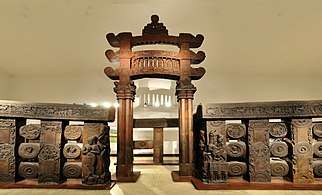 Top: Original layout of the Bharhut stupa. Bottom: East Gateway and Railings, Red Sandstone, Bharhut Stupa, 125-75 BCE.[1] Indian Museum, Kolkata. | |
 Shown within India 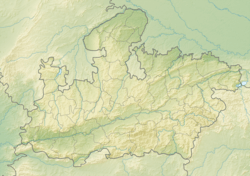 Bharhut (Madhya Pradesh) | |
| Basic information | |
| Location | India |
| Geographic coordinates | 24°26′N 80°52′E / 24.44°N 80.87°ECoordinates: 24°26′N 80°52′E / 24.44°N 80.87°E |
| Affiliation | Buddhism |
| District | Satna |
| State | Madhya Pradesh |
| Region | Vindhya Range |
| Year consecrated | 200-300 B.C. |
| Ecclesiastical or organizational status | Stupa ruins present |
| Status | Artifacts Removed |
Bharhut (Hindi: भरहुत) is a village located in the Satna district of Madhya Pradesh, central India. It is known for its famous relics from a Buddhist stupa.
The Bharhut sculptures represent some of the earliest examples of Indian and Buddhist art, later than the monumental art of Ashoka (circa 260 BCE), and slightly later than the early Sunga reliefs on railings at Sanchi Stupa No.2 (starting circa 115 BCE).[1] Recent authors date the reliefs of the railings of Bharhut circa 125-100 BCE, and clearly after Sanchi Stupa No.2, compared to which Bharhut has a much more developed iconography.[1][2] The torana gateway was made slightly later than the railings, and is dated to 100-75 BCE.[1] Many of the Bharhut remains are now located in the Indian Museum in Kolkota.
Buddhism continued to survive in Bharhut until 12th century. A Small Buddhist temple was enlarged around 1100 AD and a new statue of Buddha was installed.[3] A large Sanskrit inscription from the same period was found at the site, however it appears to have been lost.[4] This is different from the inscription Lal Pahad inscription of AD 1158 mentioning the Kalachiri kings.[5]
Bharhut stupa
Structure

The Bharhut stupa may have been first built by the Maurya king Ashoka in the 3rd century BCE, but many works of art, particularly the gateway and railings, were apparently added during the Shunga period, with many friezes from the 2nd century BCE.[6]
The central stupa was surrounded by a stone railing and four Torana gates, in an arrangement similar to that of Sanchi. A large part of the railing has been recovered, but only one of the four torana gates remains.
An epigraph on a pillar of the gateway of the stupa mentions its erection "during the rule of the Shungas by Vatsiputra Dhanabhuti".[7] The expression used is "Suganam Raje", which is thought to mean "during the rule of the Sungas", although not without ambiguity.[8] The inscription reads:
1. Suganam raje rajno Gagi-putasa Visa-Devasa
2. pautena, Gotiputasa Aga-Rajasa putena
3. Vachhi-putena Dhana-Bhutina karitam toranam
4. Sila hammata cha upahna.In the Kingdom of Sugana (Srughna) this Toran, with its ornamented stonework and plinth, was caused to be made by king Dhana-bhuti, son of Vachhi and Aga Raja son of Goti, and grandson of Visa Deva son of Gagi.
— Gateway pillar inscription of Dhana-Bhuti.[9]
Builders
Mason's marks in Kharosthi have been found on several elements of the Bharhut remains, indicating that some of the builders at least came from the north, particularly from Gandhara where the Kharoshti script was in use.[10][12][13] Cunningham explained that the Kharosthi letters were found on the ballusters between the architraves of the gateway, but none on the railings which all had Indian markings, summarizing that the gateways, which are artistically more refined, must have been made by artists from the North, whereas the railings were made by local artists.[11]
According to some authors, Hellenistic sculptors had some connection with Bharhut and Sanchi as well.[14] The structure as a whole as well as various elements point to Hellenistic and other foreign influence, such as the fluted bell, addorsed capital of the Persepolitan order, and the abundant use of the Hellenistic flame palmette or honeysuckle motif.[12] Besides the origin of its contributors however, the gateway retains a very strong Indian character in its form.[12]
It would seem the railings were the first elements to be built, circa 125-100 BCE.[15] The great gateway was built later, circa 100-75 BCE.[15] On artistic grounds, the decorations of the railings are considered later stylistically than those of Sanchi Stupa No.2, suggesting a date of circa 100 BCE for the reliefs of the railings, and a date of 75 BCE for the gateway.[15]
Excavation

In 1873, Alexander Cunningham visited Bharhut. The next year, he excavated the site.[16] Joseph David Beglar, Cunningham's assistant, continued the excavation and recorded the work through numerous photographs.
A pillar capital in Bharhut, dated to the 2nd century BCE during the Sunga Empire period, is an example of Bharhut architecture thought to incorporate Persian and Greek styles,[17][18] with recumbent animal (in the style of the Pillars of Ashoka), and a central anta capital with many Hellenistic elements (rosettes, beads-and-reels), as well as a central palmette design, in a style similar to that of the Pataliputra capital.[19][20][21]
The complex in Bharhut included a medieval temple (plate II), which contained a colossal figure of the Buddha, along with fragments of sculptures showing the Buddha with images of Brahma, Indra etc.[22] Beglar also photographed a 10th-century Buddhist Sanskrit inscription,[23] about which nothing is now known.
The ruined stupa—nothing but foundations of the main structure (see Gallery)—is still in Bharhut; however, the gateways and railings have been dismantled and reassembled at the Indian Museum, Kolkata.[7] They contain numerous birth stories of the Buddha's previous lives, or Jataka tales. Many of them are in the shape of large, round medallions. Two of the panels are at the Smithsonian.[24]
| Bharhut at the time of discovery. | |
|
As representative of early Indian art

In conformity with the early aniconic phase of Buddhist art, the Buddha is only represented through symbols, such as the Dharma wheel, the Bodhi tree, an empty seat, footprints, or the triratana symbol.[24]
The style represents the earliest phase of Indian art, and all characters are depicted wearing the Indian dhoti, except for one foreigner thought to be an Indo-Greek soldier, with Buddhist symbolism.[25] The Bharhut carvings are slightly later than the Sanchi Stupa No.2 reliefs and the earlier Ajanta frescos.
An unusual feature of the Bharhut panels is the inclusion of text in the narrative panels, often identifying the individuals.[26]
Inscriptions
The inscriptions found at Bharhut are of considerable significance in tracing the history of early Indian Buddhism and Buddhist art. 136 inscriptions mention the donors. These include individuals from Vidisha, Purika (a town somewhere in the Vindhya mountains), Pataliputra (Bihar), Karhad (Maharashtra), Bhojakata (Vidarbha, eastern Maharashtra), Kosambi (Uttar Pradesh), and Nasik (Maharashtra). 82 inscriptions serve as labels for panels depicting the Jatakas, the life of the Buddha, former Manushi Buddhas, other stories and Yakshas and Yakshinis.[26]
Structure and details
| The Bharhut Stupa | |
| Gateway | |
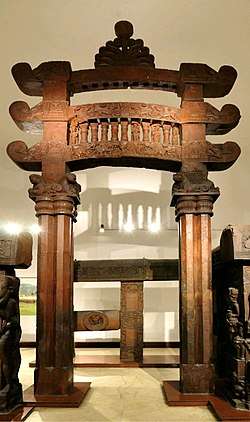 Bharhut eastern gateway. |
The Bharhut eastern gateway is the only remaining of four original gateways. It was made in 100-75 BCE (most probably 75 BCE based on artistic analysis), and is therefore posterior to the railings.[1] One of the pillar capitals, with lions, flame palmette in their back, rosettes and beads-and-reels (reconstitution). The craftsmen are thought to have been from northwestern India (probably Gandhara) as they inscribed mason's marks in Kharosthi, the script of Gandhara, throughout the gateway structure (7 such Kharoshthi mason's marks have been recorded on the gateway).[10][11][1] Gandhara was a core territory of the Indo-Greek kingdom at the time, and these craftsmen probably brought Hellenistic techniques and styles to the manufacture of the gateway.[27] On the contrary mason's marks in the local Brahmi script have not been found on the gateway, but exclusively on the railings (27 Brahmi mason's mark found), indicating that local crafstmen probably created the railings.[10][13][11] The structure as a whole as well as various elements point to Hellenistic and other foreign influence, such as the fluted bell, addorsed capital of the Persepolitan order, and the abundant use of the Hellenistic flame palmette or honeysuckle motif.[12] Besides the origin of its contributors however, the gateway retains a very strong Indian character. |
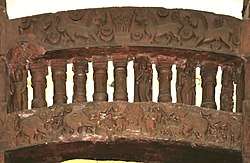 Architraves (front)  Architraves (back) |
 Reconstitution of the architraves, with position of five of the Kharosthi mason's marks. The architraves display scenes of animals who show their devotion to the Buddha (symbolized by the empty throne in the middle). The top architrave (front only) has two lions, one griffin (left), and one lion with a human head (sphinx or manticore). The bottom architraves shows four elephants and two human devotees around the symbolic Buddha. |
| Railings | |
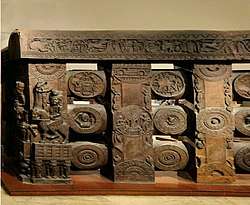 |
The railings are dated to 125-100 BCE, and most probably 100 BCE based on artistic analysis.[1] The designs are very developed, and considered as posterior to those of Sanchi Stupa No.2.[1]
All the mason's marks are in the local Brahmi script, of which 28 were found, indicating that local craftsmen probably created the railings.[11] The railings are almost entirely covered in reliefs, and display a variety of scenes, from the previous lives of the Buddha called Jatakas, to events of the life of the historical Buddha, to devotional scenes. These are also many individual medallions, thought to represent devotees or donors. |
| Scenes of devotion | |
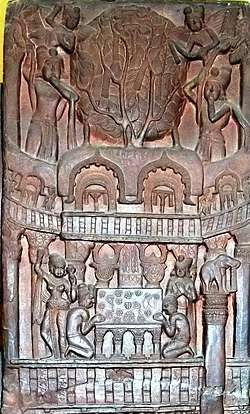 |
Diamond throne and Mahabodhi Temple around the Boddhi tree. According to the inscribed Bharhut relief related to the Diamond throne, the original Mahabodhi Temple of Asoka was an open pavilion supported on pillars.
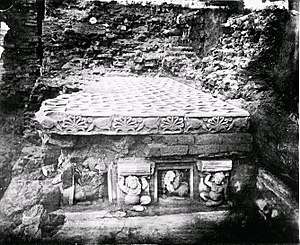 The Diamond throne shown rather exactly in the relief, was rediscovered in the 19th century. In the middle is seen the Diamond Throne or Vajrasana, decorated in front with four flat pilasters. Behind the Throne appears the trunk of the Bodhi Tree, which rises up high above the building, and on each side of the Tree there is a combined symbol of the Triratna and the Dharmachakra, standing on the top of a short pillar. On each side of the Vajrasana room there is a side room of the same style. The top of the Throne is ornamented with flowers, but there is no figure of Buddha.[28] The relief bears the inscription: "Bhagavato Sakamuni Bodhi" ("The Bodhi (Tree) of the divine Shakyamuni"), thereby confirming the meaning of the relief.[28] |
 |
Tikutiko Chakamo. The inscription above this relief mentions the "Tikutiko Chakamo", or "Three-pointed wheel" (of the law). The scene depicts seven elephants and one great three-headed Serpent (or Naga) together with two lions showing their devotion to this quite particular Wheel of the Law. |
| |
| Life of the Buddha | |
 |
Maya's Dream: The virgin conception of the Buddha. This carving of the Dream of Maya relates when the Buddha's mother had a dream about that a white elephant entering her body. This is the moment of the Buddha's conception. The sleeping queen is surrounded by three attendants, one of whom flicks a chauri. A water-pot is placed near the head of the bed; at its foot is an incense-burner. The theme of the virgin conception of the Buddha was repeated for many centuries, and was also an important theme in the Greco-Buddhist art of Gandhara. |
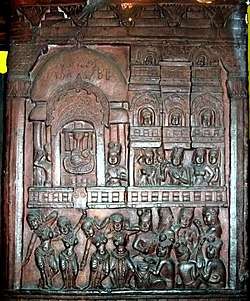 |
Worshipping Shiddharta's Hair
 The same scene at Sanchi. In the lower part of the panel is a company of deities in the Trayastrimsa heaven, where Indra held sway, rejoicing over and worshiping the hair of the Bodhisattva. The story told in the Buddhist scriptures is that, before embracing a religious life, Gautama divested himself of his princely garments and cut off his long hair with his sword, casting both hair and turban into the air, whence they were borne by the devas to the Trayastrimsa heaven and worshiped there.[31] |
 |
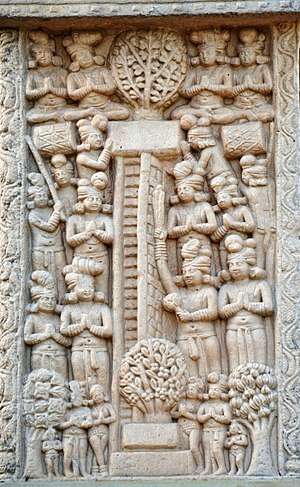 Descent of the Buddha from the Trayastrimsa Heaven, Sanchi. Descent of the Buddha from the Trayastrimsa Heaven at Sankissa. The descent of the Buddha from the Trayastrimsa Heaven, where Maya, his mother, had been reborn and whither he himself ascended to preach the Law to her. This miracle is supposed to have taken place at Sankissa (Sankasya). In the center of the relief is the miraculous ladder by which the Buddha descended, attended by Brahma and Indra. At the foot of the ladder the tree and throne, symbols of the presence of the Buddha, with devotees on either side, indicating that the Buddha has returned again to earth. |
 |
 The Jetavahana Monastery today. 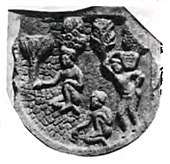 The Jetavana Monastery. The following inscription, which is placed immediately below the sculpture, gives the name of the monastery, as well as that of the builder Anatha-pindika: "Jetavana Anadhapediko deti Kotisanthatena Keta" ("Anathapindika presents Jetavana, (having become) its purchaser for a layer of kotis."), kotis being gold coins. A householder named Anathapindika had purchased the garden of Jeta for a layer of kotis, for 18 kotis of gold, and began to build. In the midst he built Buddha's pavilion. Several monastic buildings were erected by Anathapindika at Jetavana, until Gautama Buddha came from Rajagriha to Sravasti, where he was met by the wealthy man Setthi. The Blessed One, followed by a great company of monks, entered the Monastery of Jetavana. Then Anathapindika asked him, "Lord, how am I to proceed in the matter of this monastery? Since you ask me, householder, bestow this monastery upon the Buddhist clergy, present and to come.' And the great man replied, "It is well. This monastery of Jetavana I give to the clergy, present and to come, in all parts of the world, with the Buddha at their head."[32] The sculptor has apparently aimed at giving a view of the great Buddhist Vihara of Jetavana, whilst illustrating the story of its establishment by Anathapindika. In the foreground there is a bullock cart, with the bullocks unyoked sitting beside it, and with the yoke tilted up in the air to show that the cart has been unloaded. In front are two men, each holding a very small object between his thumb and forefinger. These are Anathapindika himself, and his treasurer, counting out the gold pieces brought in the cart. Above them are two other figures seated, and busily engaged in covering the surface of the garden with the gold coins, which are here represented as square pieces touching one another, as the price of its purchase. To the left are six other figures, probably Prince Jeta and his friends; and in the very middle of the composition there is Anathapindika himself carrying a vessel, just like a tea kettle, in both hands, for the purpose of pouring water over Buddha's hands as a pledge of the completion of his gift.[32] Anathapindika, who became known for his foremost generosity and character upon death entered the Tushita heaven, and became a Bodhisattva. |
| Previous lives of the Buddha (Jatakas) | |
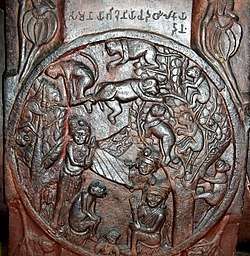 |
The Mahakapi Jataka is the centerpiece of this railing section. Mahakapi Jataka In this jataka tale, the Buddha, in a previous incarnation as a monkey king, self-sacrifyinly offers his own body as a bridge by which his fellow monkeys can escape from a human king who is attacking them. A short section of the river, across which the monkeys are escaping, is indicated by fish designs. Directly below that, the impressed humans are holding out a blanket to catch him when he falls from his position. At the very bottom (continuous narrative), the now recovered Buddha-to-be preaches to the king. (Mahakapi Jataka. Bharhut, c. 100 BCE. Indian Museum, Calcutta.) |
 |
Nigrodha Miga Jātaka. The Nigrodha Miga Jātaka (Banyan Deer Birth-story, #12 in the E.B. Cowell Jātaka stories, Volume 1) is the story of how in a past birth, born as a golden deer, Bodhisattā rescues a pregnant doe from death by slaughter. The medallion represents 3 scenes: (1) The four deers running away and one of them looking back at the far left and the man with bow at the far right represent the first scene: that of the hunt. (2) The doe lying down at the bottom left looking at the antlered deer represents the second scene: that of the pregnant doe being subjected to the slaughter today but Banyan deer tells her to go and takes her place. Cook/Butcher behind the Banyan deer watches this [and then he goes to tell the King, who comes with his entourage]. (3) The antlered deer sitting in the middle and preaching to the king [who is listening respectfully with folded hands] and his entourage is the third scene: that one should associate with good people.[33] |
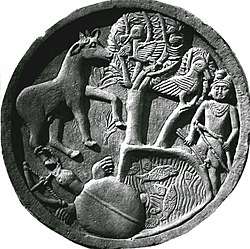 |
Kurunga Miga Jataka. This story is about three friends who lived in a forest: an antelope, a woodpecker and a tortoise. One day, the antelope was caught in the noose of a hunter, and the tortoise endeavoured to bite through the noose to free the antelope, while the woodpecker, was making cries of ill-omen, so that the hunter would remain in his hut. The antelope escaped, but the tortoise, exhausted by her efforts, was caught by the hunter. The antelope then enticed the hunter to follow her in the forest, so that the tortoise was able to flee. The antelope was the Bodhisatta, that is the Buddha in a former life, Sāriputta, a disciple of the Buddha, was the woodpecker, Moggallana, also a disciple, was the tortoise in his former life. Devadatta however, a traditional enemy of the Buddha, was the hunter.
This story is meant to demonstrate the wickedness of Devadatta, as well as the friendship and collaboration between the Buddha and his disciples, even in previous lives. |
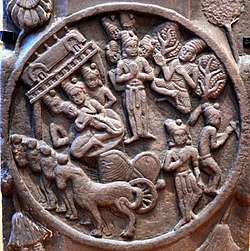 |
Muga Pakaya Jataka/ Mugapakkha Jataka/ Temiya Jataka. This is the story of "The dumb Prince". Chanda Devi, the wife of the king of Varanasi, had no son. Sakka, the king of the devas, decided to help her. He persuaded the Bodhisattva (the future Buddha), who was then in the realm of the Tavatimsa, to descend into her womb so that she could bear a child. The Bodhisattva thus entered the womb of the Queen, and when he was born was called Temiya.
Temiya then realized that his father was a king, but having himself been king of Varanasi in a previous life, a rule which ended with 20.000 years in hell, he did not want to inherit the throne. He thus decided to play dumb and inactive to avoid the inheritance. Being worthless, his father arranged for his death, and ordered the charioteer Sunanda to perform the crime. When Sunanda was digging the grave in preparation, Temiya explained to him his stratagem. Impressed, Sunanda then wanted to be an ascetic and follow Temiya. Temiya then gave a sermon to the King and the Queen. They were impressed and also expressed the wish to become ascetics. Soon, all the citizens of the kingdom, as well as two neighboring kingdoms, become followers of Temiya.[34] The relief shows Temiya as a baby in the king's lap (top left). Temiya is then seen standing behind charioteer Sunanda in the cemetery, who is digging the grave (bottom right). Temiya, as an ascetic, then gives a discourse to the people (top right). |
| |
| Individuals | |
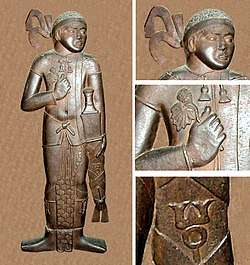 |
The Bharhut Yavana. The Greeks (specifically the Indo-Greeks) were evidently known at this date to people in the middle of India and called "Yavanas"; here, a Greek warrior has been coopted into the role of dvarapala (Guardian of a temple gate). The evidence includes his hairstyle (short curly hair with Greek royal headband), tunic, and boots. In his right hand he holds a grape plant, emblematic of his origin. The sheath of his broadsword is decorated with a nandipada, symbol of Buddhism.[35][25] There is an inscription above the relief, classified as Inscription 55 in the Pillars of Railing of the SW Quadrant at Bharhut,[36] is in the Brahmi script and reads from left to right: "Bhadanta Mahilasa thabho dânam" |
 |
 Lakshmi on a coin of Indo-Scythian king Azilises. Lakshmi. Today Lakshmi is an important deity of Hinduism, the Hindu goddess of wealth, fortune and prosperity. But she also used to be an important deity in Buddhism, where she was also a goddess of abundance and fortune, and was represented on the oldest surviving stupas and cave temples.[37] |
| |
Gallery
 Bharhut excavation
Bharhut excavation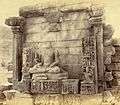 Buddha image 11-12th cent.
Buddha image 11-12th cent.- The ruined Bharhut Stupa; seen behind it is the Lal Pahadi (Red Mountain)
 Inscriptions
Inscriptions Inscriptions
Inscriptions Inscriptions
Inscriptions Inscriptions
Inscriptions- Railing section at Indian Museum.
See also
| Pilgrimage to |
| Buddha's Holy Sites |
|---|
 |
| The Four Main Sites |
| Four Additional Sites |
| Other Sites |
| Later Sites |
Notes
- 1 2 3 4 5 6 7 8 Buddhist Architecture, Huu Phuoc Le, Grafikol, 2010 p.149ff
- ↑ Didactic Narration: Jataka Iconography in Dunhuang with a Catalogue of Jataka Representations in China, Alexander Peter Bell, LIT Verlag Münster, 2000 p.18
- ↑ Report Of A Tour In The Central Provinces Vol-ix, Alexander Cunningham, 1879 p.2-4
- ↑ Buddhist Sanskrit inscription slab from about the 10th century A.D., (?)Bharhut, The British Library, 26 March 2009
- ↑ Report Of A Tour In The Central Provinces In 1873-74 And 1874-75 Volume Ix, Cunningham, Alexander, 1879, p. 38
- ↑ Marshall, John (1918). "An Historical and Artistic Description of Sanchi (pp. 7-29)". A Guide to Sanchi. Calcutta: Superintendent, Government Printing. p. 11. Retrieved 29 September 2014.
- 1 2 "Bharhut Gallery". INC-ICOM Galleries. Indian National Committee of the International Council of Museums. Retrieved 29 September 2014.
- ↑ Between the Empires: Society in India 300 BCE to 400 CE by Patrick Olivelle
- ↑ The Stupa of Bharhut, Alexander Cunningham, p.128
- 1 2 3 4 The Diffusion of Classical Art in Antiquity, John Boardman, Princeton University Press, p.115
- 1 2 3 4 5 6 "These little balusters are of considerable interest, as their sculptured statues are much superior in artistic design and execution to those of the railing pillars. They are further remarkable in having Arian letters engraved on their bases or capitals, a peculiarity which points unmistakably to the employment of Western artists, and which fully accounts for the superiority of their execution. The letters found are p, s, a, and b, of which the first three occur twice. Now, if the same sculptors had been employed on the railings, we might confidently expect to find the same alphabetical letters used as private marks. But the fact is just the reverse, for the whole of the 27 marks found on any portions of the railing are Indian letters. The only conclusion that I can come to from these facts is that the foreign artists who were employed on the sculptures of the gateways were certainly not engaged on any part of the railing. I conclude, therefore, that the Raja of Sungas, the donor of the gateways, must have sent his own party of workmen to make them, while the smaller gifts of pillars and rails were executed by the local artists." in The stūpa of Bharhut: a Buddhist monument ornamented with numerous sculptures illustrative of Buddhist legend and history in the third century B. C, by Alexander Cunningham p. 8 (Public Domain)
- 1 2 3 4 The Buddha Image: Its Origin and Development, Yuvraj Krishan, Bharatiya Vidya Bhavan, 1996, p.17-18 Note 3
- 1 2 Buddhist Architecture by Huu Phuoc Le p.161
- ↑ "There is evidence of Hellensitic sculptors being in touch with Sanchi and Bharhut" in The Buddha Image: Its Origin and Development, Yuvraj Krishan, Bharatiya Vidya Bhavan, 1996, p.9
- 1 2 3 Buddhist Architecture Huu Phuoc Le, Grafikol, 2010 p.149ff
- ↑ Cunningham, Sir Alexander (1879). The Stûpa of Bharhut: a Buddhist monument ornamented with numerous sculptures illustrative of Buddhist legend and history in the third century B.C. London: W. H. Allen.
- ↑ Early Buddhist Narrative Art by Patricia Eichenbaum Karetzky p.16
- ↑ Early Byzantine Churches in Macedonia & Southern Serbia by R.F. Hoddinott p.17
- ↑ The East: Buddhists, Hindus and the Sons of Heaven, Architecture in context II, Routledge, 2015, by Christopher Tadgell p.24
- ↑ India Archaeological Report, Cunningham, p185-196
- ↑ Age of the Nandas and Mauryas by Kallidaikurichi Aiyah Nilakanta Sastri p.376 sq
- ↑ "General view of remains of Buddhist temple of later date than the Stupa, Bharhut". Online Gallery. British Library. Retrieved 29 September 2014.
- ↑ "Photograph of a slab with a Buddhist sanskrit inscription". Online Gallery. British Library. Retrieved 29 September 2014.
- 1 2 "The Art of Buddhism". The Freer Gallery of Art and Arthur M. Sackler Gallery. Smithsonian Institution. 2008. Retrieved 29 September 2014.
- 1 2 "The Diffusion of Classical Art in Antiquity, John Boardman, 1993, p.112
- 1 2 Luders, H.; Waldschmidt, E.; Mehendale, M. A., eds. (1963). "Bharhut Inscriptions". Corpus Inscriptionum Indicarum. II. Ootacamund: Archaeological Survey of India.
- ↑ "There is evidence of Hellenesitic sculptors being in touch with Sanchi and Bharhut" in The Buddha Image: Its Origin and Development, Yuvraj Krishan, Bharatiya Vidya Bhavan, 1996, p.9
- 1 2 Mahâbodhi, Cunningham p.4ff Public Domain text
- ↑ Intercourse Between India and the Western World: From the Earliest Times to the Fall of Rome, H. G. Rawlinson Uppal Publishing House, 1992, p.142
- ↑ The Shape of Ancient Thought, Mc Evilley, Allworth Press, 2001, p.391
- ↑ A Guide to Sanchi, John Marshall p.50ff Public Domain text
- 1 2 Mahâbodhi, Cunningham p.84ff Public Domain text
- ↑ http://www.sacred-texts.com/bud/j1/j1015.htm
- ↑ The Illustrated Jataka & Other Stories of the Buddha by C.B. Varma The Story of the Dumb Prince
- ↑ Faces of Power: Alexander's Image and Hellenistic Politics by Andrew Stewart p.180
- ↑ The Stupa of Bharhut, Cunningham, p.136 )
- ↑ "The Goddess Lakshmi in Buddhist Art: The goddess of abundance and fortune, Sri Lakshmi, reflected the accumulated wealth and financial independence of the Buddhist monasteries. Her image became one of the popular visual themes carved on their monuments" in Images of Indian Goddesses: Myths, Meanings, and Models, Madhu Bazaz Wangu, Abhinav Publications, 2003, p. 57
External links
| Wikimedia Commons has media related to Bharhut. |

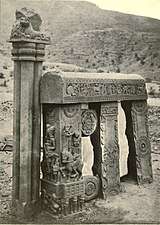

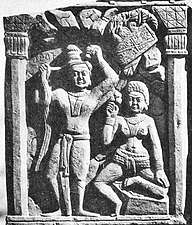
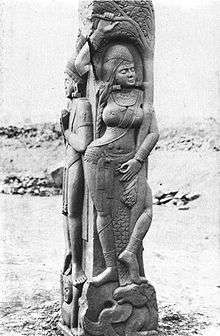

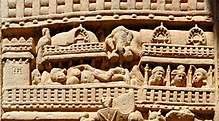
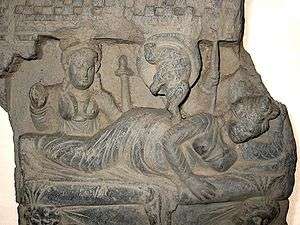
.jpg)
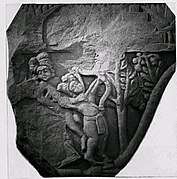


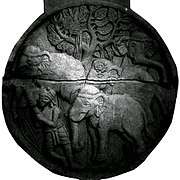
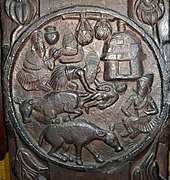

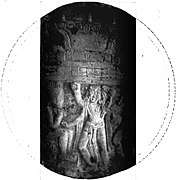
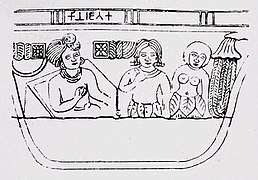




.jpg)
.jpg)
.jpg)
.jpg)
.jpg)
.jpg)
.jpg)
.jpg)
.jpg)